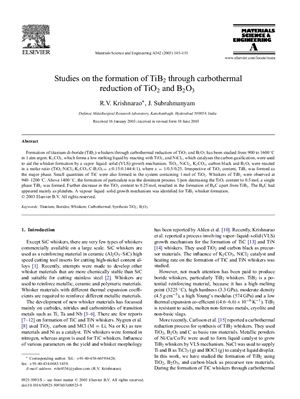Статья. Опубликована в Materials Science and Engineering A362
(2003) 145–151, Издательство Elsevier B.V. , 2003 г.
Abstract
Formation of titanium di-boride (TiB2) whiskers through carbothermal reduction of TiO2 and B2O3 has been studied from 900 to 1600 C in 1 atm argon. K2CO3, which forms a low melting liquid by reacting with TiO2, and NiCl2, which catalyses the carbon gasi?cation, were used to aid the whisker formation by a vapor–liquid–solid (VLS) growth mechanism. TiO2, NiCl2,K2CO3, carbon black and B2O3 were reacted in a molar ratio (TiO2:NiCl2:K2CO3:C:B2O3= x:0.15:0.144:4:1), where x = 1/0.5/
0.25. Irrespective of TiO2 content, TiB2 was formed as the major phase. Small quantities of TiC were also formed in the system containing 1mol of TiO
2. Whiskers of TiB2 were observed at 940–1200C. Above 1400C, the formation of particulate was the dominant process. Upon decreasing the TiO2 content to 0.5 mol, a single phase TiB2 was formed. Further decrease in the TiO2 content to 0.25mol, resulted in the formation of B4C apart from TiB
2. The B4C had
appeared mainly as platelets. A vapour–liquid–solid growth mechanism was identi?ed for TiB2 whisker formation.
Abstract
Formation of titanium di-boride (TiB2) whiskers through carbothermal reduction of TiO2 and B2O3 has been studied from 900 to 1600 C in 1 atm argon. K2CO3, which forms a low melting liquid by reacting with TiO2, and NiCl2, which catalyses the carbon gasi?cation, were used to aid the whisker formation by a vapor–liquid–solid (VLS) growth mechanism. TiO2, NiCl2,K2CO3, carbon black and B2O3 were reacted in a molar ratio (TiO2:NiCl2:K2CO3:C:B2O3= x:0.15:0.144:4:1), where x = 1/0.5/
0.25. Irrespective of TiO2 content, TiB2 was formed as the major phase. Small quantities of TiC were also formed in the system containing 1mol of TiO
2. Whiskers of TiB2 were observed at 940–1200C. Above 1400C, the formation of particulate was the dominant process. Upon decreasing the TiO2 content to 0.5 mol, a single phase TiB2 was formed. Further decrease in the TiO2 content to 0.25mol, resulted in the formation of B4C apart from TiB
2. The B4C had
appeared mainly as platelets. A vapour–liquid–solid growth mechanism was identi?ed for TiB2 whisker formation.

